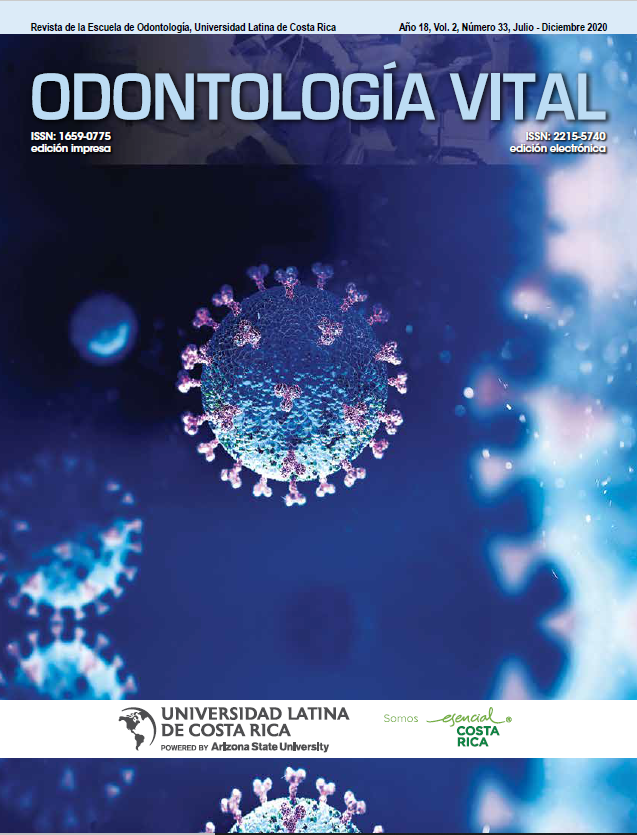Dentinogenesis imperfecta type II: Case report of two patients from the same family group
DOI:
https://doi.org/10.59334/ROV.v2i33.397Keywords:
Dentinogenesisimperfecta, Opalescent dentine, Ethiology, Dentine, Genetics, Tooth Abnormalities, Congenital AbnormalitiesAbstract
Introduction: Dentinogenesis imperfecta (DI) has been defined as a hereditary alteration of autosomal dominant character, which originates during the stage of histodifferentiation in dental development, is a type of dysplasia of dentinal tissue that affects the dentine structure of one or both dentitions. The complications of ID have a strong impact on the quality of life of patients since the functional, aesthetic and phonetic part are usually affected and represent an important challenge for the trafficker. Early diagnosis and adequate treatment are necessary to achieve better functional and aesthetic results, minimize nutritional deficiencies and psychosocial disorders, thus improving the quality of life of the person.
Objective: To determine the type of dentinogenesis, the family relationship, and the clinical characteristics of each patient.
Methods: Two brothers coming from the city of Cuenca Ecuador, ages 5 and 6 years old, come to the Odontology clinic of the Catholic University of Cuenca, respectively, for presenting multiple carious lesions. Generalized destruction of the coronary remnant and premature loss of teeth. After performing the clinical and radiographic diagnosis, family history, the diagnosis of dentinogenesis imperfecta type II was established.
Conclusion: the timely and early diagnosis of dentinogenesisimperfecta is of great importance for an adequate treatment, because the ID, affected mainly by the primary dentition, is fundamental visits to the dentist, since this will be able to diagnose the pathology at an early stage. Avoid big damages.
Downloads
References
Kawashima, N. f and Okiji, T. Odontoblasts: Specialized hard-tissue-forming cells in the dentin-pulp complex. CongenitalAnomalies, 2016; 56:144-153. https://doi.org/10.1111/cga.12169
Mason E Sweat, WenjieYu, Steve Eliason, and Brad A Arnendt. A Sox2-Lef-1 Proteinlnteractionlnhibits Lef-1 TranscriptionalActivity and WNT SignalingDuringOdontogenesis. FASEB ¡.April 201 7; 31 (7):43-48 https://doi.org/10.1096/fasebj.31.1_supplement.743.8
Martín -González J., Sánchez- Domínguez B., Tarilonte- Delgado M.L., Castellanos-Cosano L., Llamas-Carreras J.M., López-Frías F.J. et al . Anomalías y displasias dentarias de origen genético-hereditario. AvOdontoestomatol. 2012 Die; 28(6):287-30 1. https://doi.org/10.4321/S0213-12852012000600004
Muñoz Gonzalo, Ojeda Fernanda, Saez Víctor, Borle Eduardo, Borle- Echevarría Evelyn. Dentinogenesislmperfecta:A Case Report of FivePatients in theSameFamilyGroup. Int. J. Odontostomat. 2016 Ago; 10(2):215-219. https://doi.org/10.4067/S0718-381X2016000200005
Magdalena-San Martin, Leonie-Lamothe, Paula- Drexler, Raúl-Casamayou. Dentinogénesis imperfecta tipo ii: reporte de un caso. Órgano Oficial de la Asociación Latinoamericana de Odontopediatría. 2013 Die; 3(2): 93-100. https://doi.org/10.47990/alop.v3i2.46
Rodríguez, E.A., Terés, G.M., San Martín, B.IV, et al. Dentinogenesis Imperfecta Tipo II. Caso Clínico. Oral. 2004; 5(15):pp224-226.
HernandezDonaji. Dentinogenesis Imperfecta: Reporte de un caso. Revista Odontológica mexicana. 2016 Dic;10(4):ppl73-180.
Castro, Bonilla. Dentinogenesis imperfecta: reposte de un caso clínico y revisión literaria. Odontoogia vital. 201 7 Jul;2(27):pp 15-22. https://doi.org/10.59334/ROV.v2i27.206
Trejos. Revista Estomatología. Dentinogénesis imperfecta: reporte de un caso. Revista Estomatología 2007; 1 5(2): 1 9-2 7. Disponible en: https://estomatología.univalle.edu.co/index.php/estomatol/article/view/258/257
Montero Mirto. Alternativo en el tratamiento de la dentinogénesis imperfecta. Revista Cubana de estomatología. 2015 Jul;52(3):pp 374-382
Witkop, CJ. Hereditarydefects in enamel and dentin. Aeta GenetStatMed 1957;7(l):pp236-9. https://doi.org/10.1159/000150974
Martin J Barron, Sinead T McDonnell. Hereditary dentine disorders: dentinogenesisimperfecta and dentine dysplasia. Orphanet Journal of Rare Diseases. 2018 julio;3(31). https://doi.org/10.1186/1750-1172-3-31
Majorana, A .;Bardellini, E .; Brunelli, PC; Lacaita, M .; Cazzolla, AP &Favia> G. Dentinogénesis imperfecta en niños con osteogenesis imperfecta: un estudio clínico y ultraestructural. Int. J. Paediatr. . Dent. 2010; 20(2):pp 112-8. https://doi.org/10.1111/j.1365-263X.2010.01033.x
Arcos, HD; Yamamoto, A. y Trejo, R den tinogénesis imperfecta: Reporte de Caso de la ONU. Rev. odontol. . Mex. 2006;10(4):ppl73-80. [ Enlaces ] http://www.ijdrin/article.asp?issn=0970-9290;year=2008;volume=l9;issue=4;spage=357;epage=361;aulast=Bhandari
PaiAnuradha, Prasad R Shesha, Ramakrishna , Rao Raghoothama. Capdeponfs Teeth - a Hereditary Dentin Defect: Case Report & Review. Int.J. Odontostomat. 2012 Ago; 6(2):229-234. https://doi.org/10.4067/S0718-381X2012000200018
Beattie, M.L., Kim J.W, GongS.G., el al. Phenotypic Variation in DentinogenesisimperfectalDentin dysplasia Linked to 4q21. J Dent Res 2006; 85:329-333. https://doi.org/10.1177/154405910608500409
Delgado, A.C., Ruiz M., Alarcon, J.A., etal. Dentinogenesisimperfecta: The importance of early treatment. Quintessence Publishing Co; 2008:257-263.
Witkop, CJ. Hereditary defects in enamel and dentin. Aeta GenetStatMed 1957;7(l):236-9. https://doi.org/10.1159/000150974
San Martín Magdalena, LamotheLeonie. Dentinogenesis imperfecta tipo II: Reporte de un caso. Revista de Odontopediatria latinoamericana. 2013; 3(2): 93-100. https://doi.org/10.47990/alop.v3i2.46
Omañal Carlos, Jerez Elsy. Dentinogenesis imperfecta tipo ii. reporte de un caso. Acta bioclinica. 2014 junio; 4(7): 132-148.
Downloads
Published
Issue
Section
License
Copyright (c) 2020 María Eleonor Vélez León , María José Fernández Siguencia

This work is licensed under a Creative Commons Attribution 4.0 International License.
Authors who publish with Odontología Vital agree to the following terms:
- Authors retain the copyright and grant Universidad Latina de Costa Rica the right of first publication, with the work simultaneously licensed under a Creative Commons Attribution 4.0 International license (CC BY 4.0) that allows others to share the work with an acknowledgement of the work's authorship and initial publication in this journal.
- Authors are able to enter into separate, additional contractual arrangements for the non-exclusive distribution of the Odontología Vital's published version of the work (e.g., post it to an institutional repository or publish it in a book), with an acknowledgement of its initial publication.
- Authors are permitted and encouraged to post their work online (e.g., in institutional repositories or on their website) prior to and during the submission process, as it can lead to productive exchanges, as well as earlier and greater citation of published work.







